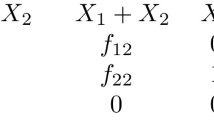Summary
Certain sections ofJosiah Willard Gibbs's thermodynamics papers might be applicable to biological equilibrium and growth, normal or abnormal.Gibbs added terms⌆ Μ i dm i to the differential of the internal energy dε=tdη−pdΝ, (t=temperature,p=pressure,η=entropy,Ν=volume) where\(\mu _i = \frac{{\delta \varepsilon }}{{\delta m_i }}\) is the potential of substancem i , to provide for chemical as well as thermal and mechanical equilibrium. In this article a further generalization is suggested, to include biological equilibrium by adding to de terms of the form GdN, the variableN being the number of cells, where\(G = \frac{{\delta \varepsilon }}{{\delta N}}\) is a “growth potential” that measures exactly the resistance toward spontaneous growth. The functionG, likeΜ i is intensive in nature (i.e. depends on intensive variables only) except for a conversion factor\(\frac{{dM}}{{dN}}\),M=⌆m i , affording possible insight into why incipient abnormal growth is often independent of the number of cells. Useful applications might follow from identities between\(\frac{{\delta G}}{{\delta \eta }},\frac{{\delta G}}{{\delta v}}\), or\(\frac{{\delta G}}{{\delta m_i }}\) and\(\frac{{\delta t}}{{\delta N}}, - \frac{{\delta p}}{{\delta N}}\) or\(\frac{{\delta \mu _i }}{{\delta N}}\) respectively. The following new function is studied,\(\bar \zeta = \zeta - GN\), a natural generalization of theGibbs free energy function ζ, the possibility of measuring it electrically, and comparison of its role with that of ζ for the possible experimental determination ofG. Gibbs's necessary and sufficient conditions for heterogeneous equilibrium ofn components inm phases are generalized and also modified to include broader restraining conditions like\(\mathop \sum \limits_{i = 1}^m \delta N_j (i) \geqslant o\),j=1,f,n, the > being characteristic of only living cellular phases. Careful appraisal of the term “biological stability” is followed by new criteria for stability, instability, and limits of stability, (neutral equilibrium) in terms of derivatives ofG, with possible medical applications. Three different sections of Gibbs's works tend to indicate that, for a biological phase, lower pressure usually increases its stability. The equation\(p'' - p' = \sigma \left( {\frac{I}{r} + \frac{I}{{r'}}} \right)\), where σ=surface tension,p′, p′ = pressures,r, r′=radii of curvature, is applied to possible control of tissue growth at interfaces. Methods of altering the equilibrum between three phasesA, B, C by varying the interfacial tensionsσ AB ,σ BC ,σ AC , using relations like AB <σ AC + BC for stability of theA, B interface, suggest different means for shifting biological equilibrium between normal and abnormal cells through the introduction of new third phases at the interface. Various devices are mentioned for possible control of growth through proper channeling of surface or other equivalent forms of energy.
Similar content being viewed by others
Literature
Donnan, F. G. (1924). The influence of J. Willard Gibbs on the science of physical chemistry. — Philadelphia, Franklin Inst., 29 p.
— &A. Haas (1936). A commentary on the scientific writings of J. Willard Gibbs: I. Thermodynamics. II. Theoretical physics. — New Haven, Yale Univ. Press.
Garrison, F. H. (1909a). Josiah Willard Gibbs and his relation to modern science. — Various sections of Pop. Sci. Mon., May, June, July and August 1909.
- (1909b). Physiology and the second law of thermodynamics. — N.Y. med. J. 1909, p. 492–498, 551–556, 594–600.
Gibbs, J. W. (1928). The collected works of J. Willard Gibbs: I. Thermodynamics. — New York, Longmans & Green. (Reprinted in 1948; there is also an earlier edition of 1906).
Groot, S. R. de (1951). Thermodynamics of irreversible processes. — Amsterdam, N.-Holl. Uitg. Mij; New York, Int. Publ.; xvi + 242 p.
Miller, W. L. (1925). The method of Wil'ard Gibbs in chemical thermodynamics. (University of Toronto studies, Papers from the Chemical Laboratories no. 152)
- Chem Rev. I, p. 293–344. (This article is more technical than Garrison, 1909a and b and Donnan, 1924).
Prigogine, I. (1947). étude thermodynamique des phénomènes irréversibles. Thèse. — Paris, Dunod, 143 p.
— (1952). Thermodynamics of irreversible processes. — Appl. Mech. Rev. V, p. 193–195
Prigogine, I. &J. M. Wiame (1946). Biologie et thermodynamique des phénomènes irréversibles. — Experientia II, p. 451–453.
Salzer, H. E. (1946). Thermodynamics in biology. — Main currents in modern thought IV, p. 55–57
Schükarew, A. N. (1907). über die energetischen Grundlagen des Gesetzes von Weber-Fechner und der Dynamik des GedÄchtnisses. — Ann. Nat. — (u. Kultur) phil. VI, p. 139–149
— (1915). über die Gleichungen der Kinetik der sozialen VorgÄnge. — Allg. statist. Arch. IX, p. 69–84.
— (1932). über die Mechanik der Massenprozesse (Kollektivgegenstandlehre). — Metron, Rovigo IX, p. 139–152.
Tunell, G. (1957). Evaluation of the chemical potential in terms of intensive quantities. — Amer. J. Sci. CCLV, p. 261–265.
Wheeler, L. P. (1952). Josiah Willard Gibbs: the history of a great mind. — New Haven, Yale Univ. Press, 270 p. (Excellent bibliography on p. 251–256.)
Author information
Authors and Affiliations
Rights and permissions
About this article
Cite this article
Salzer, H.E. Toward a gibbsian approach to the problems of growth and cancer. Acta Biotheor 12, 135–166 (1957). https://doi.org/10.1007/BF01607282
Received:
Revised:
Issue Date:
DOI: https://doi.org/10.1007/BF01607282




